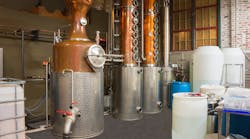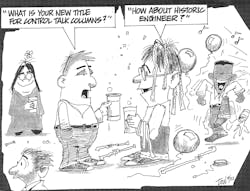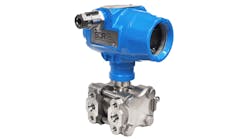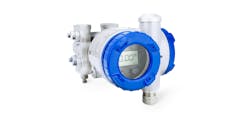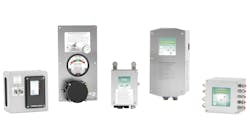Greg: We continue our conversation with Mark Darby and Doug Nicholson on achieving the best column control. Before resuming our discussion, I’d like to reiterate a point: distillation can be a challenging control problem. However, substantial benefits can accrue if done well, and a successful application can be very rewarding while improving the lives of operators. Challenges include the following:
- Control interactions: Product compositions are affected by product flow rates (distillate or bottoms) and by reflux/reboiler flow rates.
- Nonlinearities: These create difficulty in obtaining models (gains and times constants) and controlling at different values (setpoints).
- Disturbances: They arise from feed changes (rate and composition) and from the reboiler and condenser. The impact of disturbances on product compositions depends on the selected regulatory strategy for controlling column temperature(s) and levels (reflux drum and bottoms/sump) and whether feedforward control is possible.
- Long time constants/settling times: Sometimes, they encompass multiple operating shifts.
- Constrained operation: Some examples include tray loadings and condensers near limits.
- Slow unreliable updates of analyzers: This is the impact of the additional dead time that is the sample transportation delay plus 1.5 times the cycle time, and the risk of invalid results are significant.
- Process/operational challenges: These include ensuring stable operation for a range of feed rates, avoiding flooding and troubleshooting problems associated with trays or packing, as well as reboilers and condensers.
In previous Control Talk columns, Model Predictive Control (MPC) was mentioned as a possible solution to the distillation control problem. So, let’s start with when MPC should be considered?
Mark: One reason is as an alternative to advanced regulatory control (ARC). With MPC, feedforward, decoupling and constraint/override control functionalities are “built-in.” An MPC normally includes steady-state optimization with a linear objective function, which provides constraint-pushing capability. An MPC may be embedded in the DCS or in a separate computer, connected via a gateway to the DCS or PLC. The scope may cover one or more columns.
Doug: The ability to use a different manipulated variable (MV) for composition control when constraints come into play can be a significant advantage. Consider a column where the distillate product composition specification is the most important and its primary MV is the reflux. The bottoms composition is controlled with a tray temperature controller (TC) that manipulates bottoms flow. Here, the reflux drum level is controlled with the distillate and the bottoms/sump level controlled with the reboiler. Assume the column limit is flooding (downcomer back-up), inferred from a column DP measurement, which is primarily affected by reflux flow. In this situation, the reflux must be used to maintain the column DP and the TC must be used to control the top composition.
Greg: How do you determine the flood point?
Doug: When downcomer backup flooding occurs, the DP measurements increases rapidly in a nonlinear manner in response to reflux (and possibly feed flow). Once this point is reached, the reflux no longer affects the distillate composition (as the MPC model would predict). As a result, it is important to accurately identify this point. When this flooding occurs, the column material balance is impacted, i.e., reflux changes no longer affect bottoms/sump level (and reboiler flow). In the situation where bottoms/sump level is controlled with bottoms flow, the bottoms flow will not react to increases in reflux flow. A calculated material balance around the tower (feeds–products) can be helpful in making the determination.
Mark: I want to comment on jet flooding vs. downcomer back-up. These reflect two distinct regimes. Jet flooding occurs when higher vapor velocities cause liquid entrainment. Downcomer backup, as the name implies, occurs at high internal liquid flow rates in which the liquid back-ups in the downcomer (and possibly higher up the column) preventing internal liquid from flowing down the column. As pointed out by Kister in Distillation Operation, jet flooding is more likely in columns with low internal liquid/vapor (L/V) ratio and low pressure, whereas downcomer back-up is more likely in columns with high-internal L/V and higher pressure
Greg: Let’s discuss the use of smart pressure transmitters installed on nozzles to avoid impulse lines (and steam tracing). It is best to have four or more pressure transmitters to monitor the differential pressure in sections of the tower as opposed to just the entire tower.
Doug: Another example where MPC may be appropriate is a distillation train with objective of throughput maximization, where throughput-limiting constraints can appear in different columns. For example, flooding in one column and a condenser limitation (pressure controller output) in another. This is a situation where a single MPC covering multiple columns would be appropriate, possibly including other parts of the unit, e.g., an upstream reactor. Maximizing throughput against various limits can bring significant economic benefit.
Greg: What about the need and the design or configuration of regulatory controls?
Mark: A mistake is to assume that MPC will perform well regardless of the regulatory control configuration, or that it can compensate for regulatory control problems. The regulatory controls need to be evaluated and considered along with the objectives of the MPC. It should not be simply accepted as is. Normally, this means keeping or configuring a temperature controller if the temperature is sensitive to disturbances in product composition. A pressure compensated temperature is recommended if the pressure floats. Because MPC is a cascade, it makes sense to reject disturbances in the regulatory controls before they are seen in the MPC.
Greg: PID controllers where derivative action is significant, which is particularly the case for temperature controllers, can perform better than an MPC in maximizing the rejection of unmeasured load disturbances (process input disturbances), especially considering that the PID gain and rate time can be quite aggressive. MPC shifts the future trajectory, which is more effective for gradual correction of process output disturbances.
Doug: An additional advantage of a temperature controller is its linearizing effect on the MPC controls, which normally allows a greater turndown ratio of throughput. It also makes for easier model identification.
Greg: Any comments or suggestions on the modeling for MPC?
Mark: As with any controller, it is important to accurately characterize the initial part of the step response. With MPC, it is important to accurately identify the steady-state gains, as they are used by the embedded steady-state optimizer. Most MPC models are empirically identified, usually from a dedicated plant test. Sometimes historical data is used to get a preliminary MPC model or a soft-sensor model. A modeling challenge, particularly with larger controllers, is that an empirical model will have extra or fictitious degrees of freedom that the steady-state optimizer can exploit. This is because an empirical dynamic model does not automatically enforce mass or energy balances in the steady state. The solution is to remove these extra degrees of freedom by constraining model gains, guided by process knowledge or by utilizing techniques that remove small singular values or large relative gain array (RGA) elements in the steady-state gain matrix.
Doug: Since MPC can move the steady-state operating point (within zone limits), it may be necessary to compensate for static nonlinearities. If the range is sufficiently wide, linearization will be needed, using signal characterization or gain scheduling. Even if control is desired at a fixed setpoint, it may be necessary to compensate for the nonlinearities in the modeling to identify an accurate model.
Top Ten Better Titles than “Oldster” for Retired Engineers
10. Senior Engineer
9. Distinguished Engineer
8. Seasoned Engineer
7. Weathered Engineer
6. Experienced Engineer
5. Mature Engineer
4. Golden Age Engineer
3. Vintage Engineer
2. Forebearer Engineer
1. Historic Engineer
